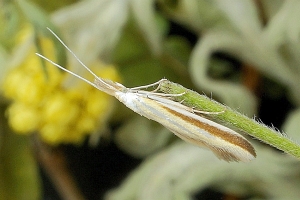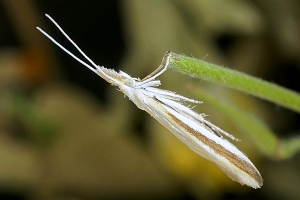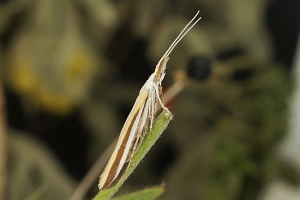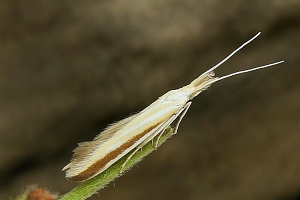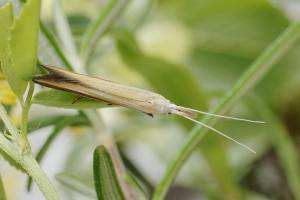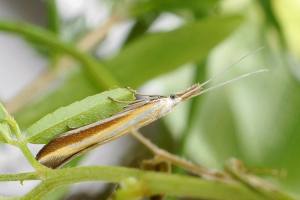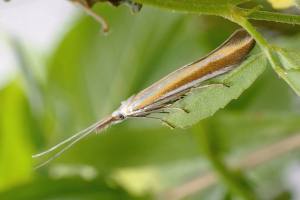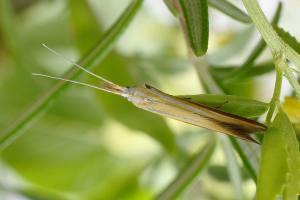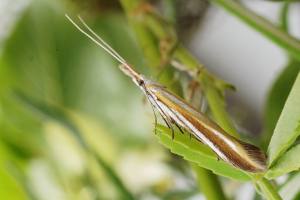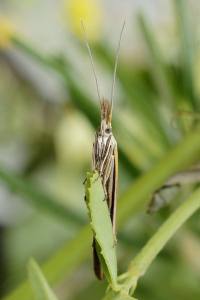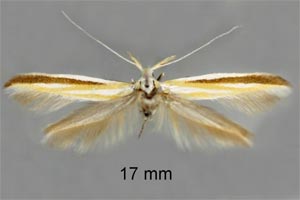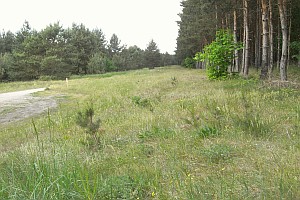


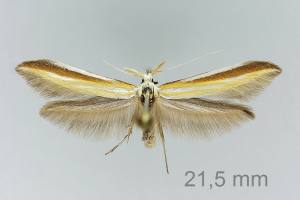


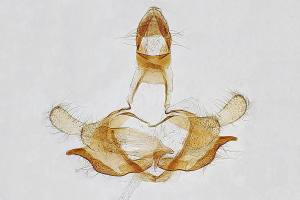
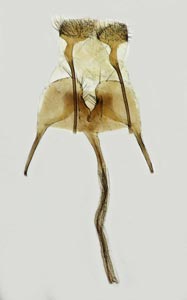


1. Lebendfotos
1.1. Falter
1.2. Raupe, Raupensack
1.3. Fraßspuren und Befallsbild
2. Diagnose
2.1. Männchen
2.2. Weibchen
2.3. Geschlecht nicht bestimmt
2.4. Genitalien
2.4.1. Männchen
2.4.2. Weibchen
2.5. Erstbeschreibung
3. Biologie
3.1. Habitat
3.2. Nahrung der Raupe
- [Asteraceae:] Artemisia campestris (Feld-Beifuß)
- [Asteraceae:] Artemisia absinthium [= Artemisia absynthium] (Wermutkraut, Echter Wermut)
- [Asteraceae:] Artemisia alba (Kempfer-Wermut)
- [Asteraceae:] Artemisia vulgaris (Gewöhnlicher Beifuß)
- [Asteraceae:] Helichrysum italicum [= Helichrysum angustifolium] (Italienische Strohblume, Italienische Immortelle, Currykraut)
- [Asteraceae:] Helichrysum italicum ssp. serotinum [= Helichrysum serotinum]
- [Asteraceae:] Helichrysum stoechas (Mittelmeer-Strohblume)
- [Asteraceae:] Helichrysum arenarium [= Gnaphalium arenarium] (Sand-Strohblume)
- [Asteraceae:] Tanacetum vulgare [= Chrysanthemum vulgare]
- [Asteraceae:] Achillea millefolium (Gewöhnliche Schafgarbe)
- [Asteraceae:] Anthemis tinctoria [= Cota tinctoria] (Färberkamille, Färber-Hundskamille)
- [Asteraceae:] Filago arvensis (Acker-Filzkraut)
- [Asteraceae:] Centaurea sp.
Die Raupen von C. caelebipennella sind schon von Herbst an bis in den Mai hinein an dürftig bewachsenen Stellen zu finden. Angenommen werden verschiedene Asterngewächse wie Wermut (Artemisia absinthium), Feldbeifuß (Artemisia campestris), Rainfarn (Tanacetum vulgare), Schafgabe (Achillea millefolium), Flockenblume (Centaurea sp.). Der unter Diagnose gezeigte Raupensack wurde zusammen mit C. vibicigerella an Wermut (Artemisia absinthium) gefunden. Die Säcke sehen im Jugendstadium fast gleich aus. Sie differenzieren sich erst im Frühjahr. [Friedmar Graf]
Insgesamt scheint die Art ein relativ breites Spektrum an Asteraceae als Raupennahrung zu nutzen. Die lange Liste von Baldizzone (2019: 280) ist durchweg plausibel: "Piante nutrici appartengono tulle alla famiglia Asteraceae: Artemisia absinthium, A. alba, A. campestris, A. vulgaris, Achillea millefolium, Centaurea spp., Chrysanthemum spp., Filago arvensis, Helichrysum arenarium, H. italicum, H. stoechas, H. angustifolium, Tanacetum vulgare." Die Liste von [Bladmineerders.nl (abgefragt 27. Juli 2022)] ist fast identisch: Achillea millefolium; Artemisia absinthium, alba, campestris, vulgaris; Centaurea; Chrysanthemum; Gnaphalium; Helichrysum arenarium, italicum & subsp. serotinum, stoechas; Tanacetum vulgare." Hinzu kommt aber: "Ivinskis & Savenkov add Cota tinctoria." und "It is not clear whether the reference to “Chrysanthemum” (by, among others, Hering (1957a)) refers to Chrysanthemum sensu stricto, Leucanthemum, or Tanacetum. It will not be the most important host plant anyway. For Suire (1961a) that are Helichrysum species, for Patzak (1974a) Artemisia campestris." Da Tanacetum vulgare gut belegt ist (u.a. auch durch Angaben unserer Mitarbeiter), wird hier unterstellt, dass sich "Chrysanthemum" auf diese Art bezog. Und mit "Gnaphalium dürfte Helichrysum arenarium oder eine andere Helichrysum-Art gemeint gewesen sein.
(Autor: Erwin Rennwald)
4. Weitere Informationen
4.1. Andere Kombinationen
- Multicoloria caelebipennella (Zeller, 1839) [so bei Anikin et al. (2017)]
4.2. Synonyme
- Coleophora bifurcella Turati, 1930 [synonymisiert von Baldizzone (1979: 122)]
4.3. Typenmaterial
Baldizzone (1994: 122) designierte einen Lectotypus: “Lectotypus ♂ [designato in questa sede] conservato al BMNH, reca le seguenti etichette: 1) “LECTOTYPE” (a stampa, rotondo, orlato di blu), 2) “Cälebipennella Ti. Is. 1839, 206” (a mano), 3) “Zeller Coll. Walsingham Collection, B.M. 1910-427.” (a stampa), 4) “B.M. ♂ Genitalia slide No. 11028” (a mano e stampa).”
Baldizzone (1979: 122) hatte bereits einen Lectotypus für das Synonym Coleophora bifurcella designiert: “Lectotypus ♂ (PG 1202 BLDZ): « Typus, Cyrenaica, R. U. Agrario 17962, Geo. C. Krüger, Derna, IV. 29, Cyrenaica », coll. Turati, in coll. HARTIG, Bolzano.”
(Autor: Jürgen Rodeland)
4.4. Literatur
- Anikin, V.V., Sachkov, S.A. & V.V. Zolotuhin (2017): "Fauna lepidopterologica Volgo-Uralensis": from P. Pallas to present days. — Proceedings of the Museum Witt Munich, Volume 7: 1-696; Munich and Vilnius.
- Baldizzone, G. (1979): Contribuzioni alla conoscenza dei Coleophoridae XVI. Nuove sinonimie nel genere Coleophora Hübner. — Entomologica 15: 121-125. Bari. [Zum PDF auf ojs.cimedoc.uniba.it]
- Lectotypus-Festlegung: Baldizzone, G. (1994): Contribuzioni alla conoscenza dei Coleophoridae LXXV. Coleophoridae dell'Area Irano-Anatolica e regioni limitrofe (Lepidoptera). — Associazione Naturalistica Piemontese Memorie 3: 1-423. Stenstrup (Apollo Books).
- Будашкин, Ю. И., Рихтер, И. & Ю. Табель (2015): Новые находки молей-чехлоносок (Lepidoptera: Coleophoridae) в России и в Армении. — Эверсманния 41: 11–22.
- Резник, С. Я. (1977): К фауне чехлоносок рода Multicoloria Căp. (Lepidoptera, Coleophoridae) Тувы и Монголии [Reznik, S. J. (1977): On the fauna of the genus Multicoloria Căp. (Lepidoptera, Coleophoridae) of Tuva and Mongolia]. — Насекомые монголии 5: 606-614.
- Ivinskis, P. & N. Savenkov (1991): Casebearers of the Baltic republics (Lepidoptera: Coleophoridae). — Phegea, 19(4): 149-167.
- Резник, С. Я. (1976): К фауне чехлоносок рода Multicoloria Căp. (Lepidoptera, Coleophoridae) Дальнего Востока [Reznik, S. J. (1976): On the fauna of the genus Multicoloria Căp. (Lepidoptera, Coleophoridae) of the Far East]. — Труды Зоологического института Академия наук СССР 62: 109-113.
- [SCHÜTZE (1931): 190]
- Stainton, H. T. (1860): The natural history of the Tineina 5: I-IX, 1-228, pl. IX-XVI. London (John van Voorst) – Paris (Deyrolle) – Berlin (E. S. Mittler und Sohn). — Digitalisat auf archive.org: [22-29], [pl. IX fig. 3].
- Erstbeschreibung: Zeller, P. C. (1839): Versuch einer naturgemäßen Eintheilung der Schaben. — Isis von Oken 1839 (3): 167-220. Leipzig (Brockhaus).



![Vorkommen in Österreich [Huemer (2013: NR 1720)]](/res/img/flag/at.png)
![Vorkommen in Norwegen (außer Spitzbergen und Jan Mayen) [Aarvik & al. (2017): Nordic-Baltic Checklist]](/res/img/flag/no.gif)
![Vorkommen in Dänemark (außer Färöer-Inseln und Grönland) [Aarvik & al. (2017): Nordic-Baltic Checklist]](/res/img/flag/dk.gif)
![Vorkommen in Schweden [Aarvik & al. (2017): Nordic-Baltic Checklist]](/res/img/flag/se.gif)
![Vorkommen in Finnland (außer Åland-Inseln) [Aarvik & al. (2017): Nordic-Baltic Checklist]](/res/img/flag/fi.gif)
![Vorkommen in Russland (europäischer Teil bis Manytsch-Niederung) [Будашкин, Рихтер & Табель (2015: 14)]](/res/img/flag/ru.gif)
![Vorkommen in Estland [Aarvik & al. (2017): Nordic-Baltic Checklist]](/res/img/flag/ee.gif)
![Vorkommen in Lettland [Aarvik & al. (2017): Nordic-Baltic Checklist]](/res/img/flag/lv.gif)
![Vorkommen in Litauen [Aarvik & al. (2017): Nordic-Baltic Checklist]](/res/img/flag/lt.gif)
![Vorkommen in Polen [Buszko J. & J. Nowacki [eds] (2017): A Distributional Checklist of the Lepidoptera of Poland]](/res/img/flag/pl.gif)
![Vorkommen in Tschechien [Laštůvka, Z. & J. Liška (2011): Komentovaný seznam motýlů České republiky]](/res/img/flag/cz.gif)

![Vorkommen in Ungarn [Pastorális et. al. (2018): A Magyarországon előforduló molylepke-fajok névjegyzéke]](/res/img/flag/hu.gif)
![Ausgestorben oder verschollen in den Niederlanden [Kuchlein & de Vos (1999): Annotated Checklist of the Dutch Lepidoptera]](/res/img/flag/nl.gif)
![Vorkommen in Frankreich (europäisches Territorium ohne Korsika) [Vandromme et al. (2020): Liste systématique et taxinomique des Lépidoptères de France]](/res/img/flag/fr.gif)
![Vorkommen auf Korsika [Brusseaux, G. & J. Nel (2004)]](/res/img/flag/fr-cor.png)
![Vorkommen in Spanien (Festland) [Vives Moreno A. (2014)]](/res/img/flag/es.gif)
![Vorkommen in Italien (Festland und kleine festlandsnahe Inseln) [Baldizzone et al. (1995): Checklist delle Specie della Fauna Italiana 83]](/res/img/flag/it.gif)
![Vorkommen in Slowenien [Lesar & Govedič (2010): Check list of Slovenian Microlepidoptera]](/res/img/flag/si.gif)
![Vorkommen in Rumänien [Rákosy L. & M. Goia (2021): Lepidopterle din România: lista sistematică şi distribuţie]](/res/img/flag/ro.gif)
![Vorkommen im asiatischen Teil der Türkei [Baldizzone (1994: 122); Koçak & Kemal (2018)]](/res/img/flag/tr.gif)
![Vorkommen in Afghanistan [Baldizzone (1994: 122)]](/res/img/flag/af.gif)
![Vorkommen in Pakistan [Baldizzone (1994: 122)]](/res/img/flag/pk.gif)
![Vorkommen in Libyen [Baldizzone (1979: 122): Locus typicus des Synonyms C. bifurcella]](/res/img/flag/ly.gif)





